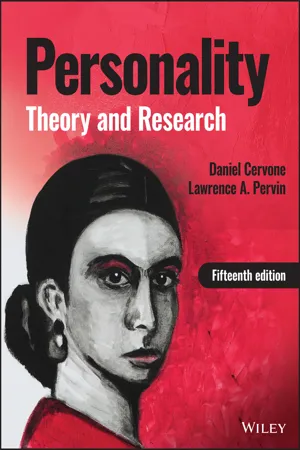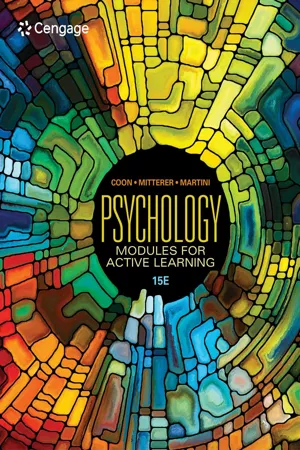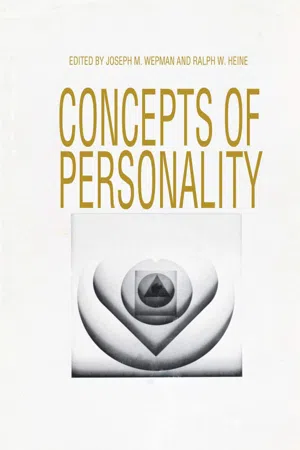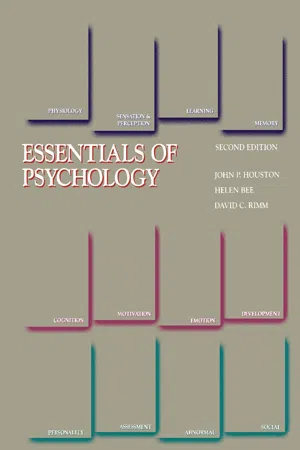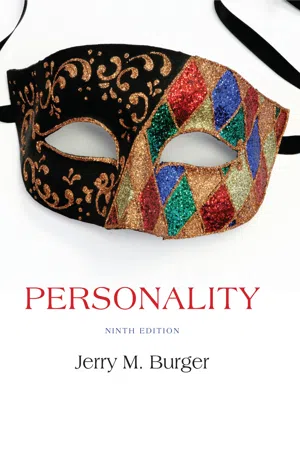Psychology
Behavioral Theory of Personality
The Behavioral Theory of Personality suggests that our behavior is learned through interactions with the environment. It emphasizes the role of conditioning and reinforcement in shaping personality traits and patterns of behavior. This theory focuses on observable behaviors rather than internal mental processes, and it has been influential in understanding how individuals develop and display different personality characteristics.
Written by Perlego with AI-assistance
Related key terms
1 of 5
10 Key excerpts on "Behavioral Theory of Personality"
- eBook - PDF
Personality
Theory and Research
- Daniel Cervone, Lawrence A. Pervin(Authors)
- 2022(Publication Date)
- Wiley(Publisher)
To get this scientific explanation, you need more than a philosophical position. You need a specific scientific theory—or theories—that are supported by data and that explain the feelings and behaviors that people talk about when describing their “personality.” To this end, behaviorists rely on what are called theories of “learning.” In psychology, the term “learning” is used very broadly. It refers to any enduring change in behavioral abilities or emotional tendencies that results from experience with the environment. We may not normally think of personality as being “learned”—but with this broad definition of “learning,” the idea is reasonable. If you had been raised in isolation from human society, with no social and cultural learning experiences, you surely would not have been the person that you are today. Almost all of your everyday behaviors—sending a text message, planning what to do next weekend, encouraging a depressed friend—would be impossible without learning experiences. This chapter presents two theories of learning. They are not opposing views. Rather, they are complementary; they highlight different aspects of how people learn from environmental experi- ences. In combination, these two ideas—Pavlov’s classical conditioning and Skinner’s operant conditioning theories—provided the scientific foundation that supported the conceptual view- point that is behaviorism. During the middle of the 20th century, behaviorism was the predominant school of thought in scientific psychology. Later in the century, its influenced declined precipitously. Nonetheless, the study of operant and classical conditioning remains a part of the contemporary field (Dom- jan, 2005; Staddon & Cerutti, 2003). Why—you may already be asking—should I learn about a school of thought that already has declined in influence? Four considerations motivate the study of behaviorism in contemporary personality theory and research. - No longer available |Learn more
Psychology Applied to Modern Life
Adjustment in the 21st Century
- Wayne Weiten, Dana Dunn, Elizabeth Hammer(Authors)
- 2014(Publication Date)
- Cengage Learning EMEA(Publisher)
Evaluating Behavioral Perspectives Behavioral theories are firmly rooted in empirical research rather than clinical intuition. Pavlov’s model has shed light on how conditioning can account for people’s sometimes troublesome emotional responses. Skinner’s work has demonstrated how personality is shaped by the conse- quences of behavior. Bandura’s social cognitive theory has shown how people’s observations mold their characteristic behavior. Behaviorists, in particular Walter Mischel (1973, 1990), have also provided the most thorough account of why people are only moderately consistent in their be- havior. For example, a person who is shy in one context might be quite outgoing in another. Other models of per- sonality largely ignore this inconsis- tency. The behaviorists have shown that it occurs because people be- have in ways they think will lead to reinforcement in the situation at hand. In other words, situational factors are important deter- minants of behavior. Thus, a major contribution of the behavioral per- spective has been its demonstration that personality factors and situational fac- tors jointly and interactively shape behavior (Funder, 2009; Reis & Holmes, 2012). Of course, each theo- retical approach has its shortcomings, and the be- havioral approach is no exception. Major lines of Copyright 2013 Cengage Learning. All Rights Reserved. May not be copied, scanned, or duplicated, in whole or in part. Due to electronic rights, some third party content may be suppressed from the eBook and/or eChapter(s). Editorial review has deemed that any suppressed content does not materially affect the overall learning experience. Cengage Learning reserves the right to remove additional content at any time if subsequent rights restrictions require it. 48 CHAPTER 2 criticism include the following (Liebert & Liebert, 1998; Pervin & John, 2001): 1. - eBook - PDF
Psychology
Modules for Active Learning
- Dennis Coon, John Mitterer, Tanya Martini, , Dennis Coon, John Mitterer, Tanya Martini, (Authors)
- 2021(Publication Date)
- Cengage Learning EMEA(Publisher)
463 MODULE 53 with personality? Everything, according to the behavioral viewpoint. Behavioral personality theories emphasize that per-sonality is no more (or less) than a collection of relatively stable learned behavior patterns. (For a discussion of leader-ship as a collection of relatively stable and definitely learn-able, behavior patterns, see Module 54.) Personality, like other learned behavior, is acquired through classical and Personality Behavioral and Social Learning Theories Why is little Sue so aggressive? His daddy named him Sue af-ter an old country song. Freud believed that aggressive urges are “instinctual.” Unlike psychodynamic and humanistic the-orists, behavioral theories assume that personal characteris-tics such as aggressiveness are learned. Could Sue’s aggression be the result of observational learning, harsh punishment, or prior reinforcement? Sue will tell you himself that his name always triggers giggles from girls. Boys always laugh at and taunt him. The resulting fights are, to Sue, an inevitable part of his life. So why did his father name him Sue, you ask? To toughen him up, the dirty, mangy dog said, before he abandoned his fam-ily when Sue turned three. All kidding aside, behavioral and social learning theories are based on scientific research, which makes Learning Outcome 53.1 Describe how behaviorists and social learning theorists explain personality After exploring psychodynamic theories, you might be re-lieved to know that behavioral theorists explain personality through straightforward concepts, such as learning, rein-forcement, and imitation. Behaviorists have shown repeat-edly that children can learn things like kindness, hostility, generosity, or destructiveness. - eBook - ePub
- Joseph M. Wepman(Author)
- 2017(Publication Date)
- Routledge(Publisher)
There is no reason to assume that the study of personality offers any new or unique problems for psychology. We can consider the study of personality to be a branch of the general field of learning which investigates in particular those processes significant to human adjustment. To be sure, many contemporary “learning” psychologists prefer to limit themselves to studies of lower animals and are reluctant to use human subjects or to extrapolate their findings to human behavior. Nevertheless, other behaviorists are willing to concern themselves with the problems related to early behavioral development, to motivation, to the effects of aversive stimuli on behavior and the behavioral consequences of frustration and conflict as well as problems of behavior pathology and the role of learning in psychotherapy. It is encouraging to note that today many behaviorists who follow Skinnerian principles are applying their attitudes and methodology to the study of human behavior. Some work at the subhuman level has been given as experimental and demonstrable proof of certain clinical insights. More and more these behaviorists are applying their experimenting to the level of human responding and. discovering principles in their own right instead of merely relying on animal studies alone from which they can extrapolate.It is evident, then, that all behaviorists do not think alike, even those who might concern themselves with the study of personality. Hence, when one asks specifically, “What is the behaviorist’s conception of personality?” he must realize that the answer offered on these pages must be qualified as that of one behaviorist—the writer of this chapter. Because the vast majority of man’s behavior is learned, the first problem in personality study is to determine under what conditions behavior is acquired. Once this is accomplished, the next problem is that of comprehending the apparent exceptions to the general law. At this point the behaviorist as a student of learning enters more fully into the field of personality. We realize that each individual develops under a different or unique set of stimulus conditions and consequently his resulting personality becomes uniquely his own. Personalities that we may designate as peculiar or abnormal, have had, among other things, unusual conditioning histories. People behave similarly, within the limits of their biological endowment, to the degree that they have been conditioned in the same manner. The unique kinds of behavior patterns one acquires over the long history of his psychological development is the behavior peculiar to him and constitutes his - eBook - PDF
- John P. Houston, Helen Bee, David C. Rimm(Authors)
- 2013(Publication Date)
- Academic Press(Publisher)
Those behaviors and dispositions we label as personality are no different from any other behaviors. AÎÎ behavior, in-cluding that labeled personality, is learned, and is governed by the prin-ciples of conditioning discussed in Chapter 4. Reinforcement and punishment The learning approach states that rein-forcement shapes our personality. If we are raised in an environment in which even-tempered behavior is rewarded and emotional outbursts are punished, then we will tend to display calm behavior in the future. It has worked for us in the past, so it becomes part of our personality. Reinforce-ment can be of a primary nature, such as food, sleep, sex, or warmth. It can be social, such as praise and encouragement from others, or it can be self-administered in such forms as self-congratulations or a relaxing swim after a good day's work. Punishment can also be an effective shaper of personality. If a child is repeatedly punished, by being told to be quiet or being sent out of the room whenever she speaks in the presence of adults, she may acquire a shy or socially inhibited trait. Qeneralization and discrimination We discussed these two principles of basic conditioning in Chapter 4- They are often evoked in connection with the learning approach to personality. According to the principle of generalization, if we are rewarded for a particular behavior in a certain situation, we will tend to do the same thing in similar situations. For example, if a child has learned that temper tantrums work at home, he may try them at school and on the playground. But not all environments will reward the same behaviors. A temper tantrum may gain attention at home and only be laughed at on the playground. Thus, according to this view, we learn to discriminate between situations in which a particular be-havior will lead to reward and situations in which it will not be rewarded. Discrimination explains how a given individual can show so many dif-ferent kinds of behavior. - eBook - PDF
- Jerry Burger(Author)
- 2018(Publication Date)
- Cengage Learning EMEA(Publisher)
Although behaviorism’s influence has diminished over the last half century or so, this does not mean that the contributions made by behaviorists were wrong or have been replaced. More accurately, the discipline has grown, and the basic concepts that made up the earlier behavioral approach have been built upon and expanded. Initially, behaviorists limited their descriptions to observable behaviors. Later, social learning theory expanded the scope of the approach to include unobservable concepts like thoughts, values, expectancies, and individual perceptions. Social learning psy- chologists also recognized that people can learn simply by watching someone else or even hearing about another person’s behavior. In the past few decades, many behav- ioral psychologists have moved toward invoking cognitive concepts into their expla- nations of behavior, so much so that today the line between behavioral and cognitive approaches to personality is sometimes blurred. Practitioners who once wore the label “behavioral therapists” now refer to themselves as “cognitive-behavioral therapists.” As we will see, both traditional behaviorism—presented next—and the cognitive approaches to personality described in Chapter 15 have a lot to tell us about the causes of personality and avenues for change. Behaviorism I n 1913, a young and brash psychologist named John B. Watson published an article titled “Psychology as the Behaviorist Views It.” This article signaled the beginning of a new movement in psychology called behaviorism. By 1924, with the publication of his book Behaviorism, Watson had made significant progress in his effort to redefine the discipline. He argued that if psychology is to be a science, psychologists must stop examining mental states. Only the observable was reasonable subject matter for a sci- ence, and because subjective inner states and feelings cannot be observed or measured in an agreed-upon, accurate manner, they have no place in psychology. - Lorelle J. Burton, Drew Westen, Robin M. Kowalski(Authors)
- 2022(Publication Date)
- Wiley(Publisher)
Cognitive– social theories share the behaviourist belief that learning (rather than instinct, conflict or defence) is the basis of personality and that personality dispositions tend to be relatively specific and shaped by their consequences. However, they also focus on beliefs, expectations and information processing. According to this approach, personality reflects a constant interplay between environmental demands and the way the individual processes information about the self and the world. Thus, people’s actions reflect an interaction between the requirements of the situation (e.g., in school people are expected to work hard, come to class on time and follow the directives of teachers) and the person’s learned tendencies to behave in particular ways under particular circumstances. These tendencies reflect their knowledge and beliefs. For example, Albert Bandura (1986, 1999) argues that people are not driven by inner forces, as proposed by many psychodynamic theories, nor are they automatically shaped and controlled by external stimuli, as asserted by behaviourists such as B. F. Skinner. Rather, people’s actions reflect the schemas they use in understanding the world, their expectations of what will happen if they act in particular ways, and the degree to which they believe they can attain their goals. Whereas psychodynamic theory centres on the irrational, cognitive–social theories tend to be eminently rational. Whereas behaviourists downplay the role of thought in producing behaviour, cognitive–social theorists emphasise it. According to cognitive–social theories, several conditions must be met for a behaviour to occur (see figure 14.5) (Bandura, 1977b, 1986, 1999, 2001; Mischel & Shoda, 1998). The person must encode the current situation as relevant to their goals or current concerns, and the situation must have enough personal meaning or value to initiate goal-driven behaviour.- eBook - PDF
- Jerry Burger, , , , Burger(Authors)
- 2014(Publication Date)
- Cengage Learning EMEA(Publisher)
Psychologists questioned the assertion that all human learning is the result of classical or operant conditioning. “ The prospects for survival would be slim indeed if one could learn only from the consequences Social Learning Theory 353 Copyright 2015 Cengage Learning. All Rights Reserved. May not be copied, scanned, or duplicated, in whole or in part. Due to electronic rights, some third party content may be suppressed from the eBook and/or eChapter(s). Editorial review has deemed that any suppressed content does not materially affect the overall learning experience. Cengage Learning reserves the right to remove additional content at any time if subsequent rights restrictions require it. of trial and error, ” one psychologist wrote. “ One does not teach children to swim, adolescents to drive automobiles, and novice medical students to perform surgery by having them discover the requisite behavior from the consequences of their successes and failures ” (Bandura, 1986, p. 20). Psy-chologists also began to question whether behaviorism was too limited in the scope of its subject matter. Why couldn ’ t “ internal ” events like thoughts and attitudes be conditioned the same way as overt behaviors? For example, paranoid individuals who believe evil agents are out to get them might have been reinforced in the past for these beliefs. Thus began the transition from traditional behaviorism to a number of approaches known collectively as social learning theory. One of the concepts introduced by social learning theorists is the notion of behavior-environment-behavior interactions (Staats, 1996). That is, not only does the environment influence our behavior, but that behavior then deter-mines the kind of environment we find ourselves in, which can then influence behavior, and so on. The way people treat you (environment) is partly the result of how you act (behavior). And, of course, how you act is partly a result of how people treat you. - eBook - PDF
- Ronald Comer, Elizabeth Gould, Adrian Furnham(Authors)
- 2014(Publication Date)
- Wiley(Publisher)
You may in turn have developed a confident belief that you were a good student. Your high level of self-efficacy may have led you to persist in behaviours (listening, com- pleting your homework, studying) that led to more desired reinforcements (praise, good grades, positive self-image). The major advantage of this perspective over other the- ories of personality is that it is readily testable. Its special emphasis on observable variables – such as models, behav- iours, goals and outcomes –makes testing it much easier than testing, say, the abstractions of humanistic theory. And FIGURE 15.4 Bandura’s theory of reciprocal determination. In Bandura’s view, personality is determined by the interaction of the external environment, internal mental events and behaviour. Internal mental events Behaviour Personality External environment Film and television are powerful media. The stories conveyed in movies and TV shows can make us laugh, cry or get angry. But can they fundamentally affect our personality or influence how we act? This is a subject of much debate among parents, psychologists and government organizations. In one study, movie clips of violent acts were shown to uni- versity students to see whether the brain’s response to aggres- sion changes with repeated viewing. The researchers found that a region of the brain partly responsible for regulating aggression was less active after repeated exposure to violence (Kelly et al. , 2007). Such findings have raised concern among scientists and the public. At the same time, it is important to recognize that although the average person views 200,000 dramatized acts of violence by the age of 18, most university- aged individuals are far from violent (Finley, 2007). In short, as we noted in Chapter 9, TV and movie viewing may indeed have a potential relationship to aggressive behaviour, and per- haps to other undesirable behaviours as well. - eBook - PDF
Counseling and Psychotherapy Theories in Context and Practice
Skills, Strategies, and Techniques
- John Sommers-Flanagan, Rita Sommers-Flanagan(Authors)
- 2018(Publication Date)
- Wiley(Publisher)
THEORETICAL PRINCIPLES There have been many formulations and reformulations of behavioral theory and therapy (Farmer & Nelson-Gray, 2005). Two primary convictions characterize behaviorists and behavioral theory—both then and now: 1. Behavior therapists employ techniques based on mod-ern learning theory. 2. Behavior therapists employ techniques derived from scientific research. Some behaviorists have criticized even these most basic behavioral tenets. For example, Lazarus wrote: Eysenck’s … insistence that behavior therapy denotes “methods of treatment which are derived from modern learning theory” amounts to little more than a beguiling slogan. … The danger lies in a premature elevation of learning principles into unwarranted scientific truths and the ascription of the general term of “modern learning theory” to what in reality are best described as “modern learning theories.” (Lazarus, 1971, pp. 4, 5) Lazarus’s point is that there is no single “learning theory,” but instead, many learning theories (in the plu-ral). He asserted that even psychoanalytic formulations constitute learning hypotheses, many of which remain unsubstantiated. THEORETICAL PRINCIPLES 171 Theoretical Models We turn now to a brief description of the two main mod-els of learning that form the theoretical foundation of behavior therapy (Farmer & Nelson-Gray, 2005; Fishman & Franks, 1997). In Chapter 8, we look at two additional learning models that focus on cognitive learning. Operant Conditioning: Applied Behavior Analysis Applied behavior analysis is a clinical term referring to a behavioral approach based on operant conditioning principles. Operant conditioning (also called instru-mental conditioning) is a form of behavior modification that involves manipulation of behavioral antecedents and consequences. The operant conditioning philosophy is: Behavior is a function of its consequences. B. F. Skinner expanded on Thorndike’s (1932) origi-nal learning theory and developed operant conditioning.
Index pages curate the most relevant extracts from our library of academic textbooks. They’ve been created using an in-house natural language model (NLM), each adding context and meaning to key research topics.
